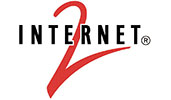"Jumbo" Frames and Internet2
Large IP frames, also called "jumbograms" or "jumboframes," have been recommended for high-performance networkslike Internet2 as a significant factor in increasing performance overlong distances. In general the limiting factor in frame size is theIP MTU (Media Transmission Unit, sometimes also called MaximumTransmission Unit), which by default on an Ethernet is 1500 bytes.The MTU is set independently for every interface in an IP flow'spath, and any interface can limit the size of the flow by fragmentingit. Path MTU discovery, described in RFC1191,attempts to discover the optimal MTU for the path to avoid fragmentation.
The Internet2 recommendation is to work toward an end-to-end IP MTU ofat least 9000 bytes today, and eventually much larger. Steps in thiseffort are:
- Set 9KB MTUs throughout the Internet2 backbone. This has been completed.
- Internet2 and its connectors work together to set 9KB MTUs where we peer with each other. See the table below for an indication of the progress of this effort.
- The Internet2 institutions set 9KB MTUs within their networks, at least to the high-performance end-stations.
This page gives links to some of the reasoning for a large-frame recommendation, indicates some of the organizations and networks who have endorsed the concept and are working with us to increase MTUs, shows how it is done with Cisco and Juniper examples, and finally includes a list of all Internet2 connectors and peer networks and their current MTU status.
- theoretical background for large MTUs
- Mathis "MTU Discovery and Jumbogram Resources"
- Mathis "Raising the Internet MTU" For background information and discussion of the larger problem, including implementations, bibliography, and arguments from others, pro and con
- Mathis presentation for JET and Feb 2003 Joint Techs
- Almes-Summerhill Internet2 statement
- practical considerations with regard to large MTUs
- groups endorsing large MTUs
- JET: U.S.A. Federal & academic research networks coordinating group, with representatives from Internet2, DREN, ESNET, NISN, NREN, USGS, vBNS, and others.
- configuration examples
- further discussion
- MTU list (mtu@psc.edu; email majordomo@psc.edu with 'subscribe mtu' in the body)
-
"jumbo-clean" list (jumbo-clean@lists.uoregon.edu; email majordomo@lists.uoregon.edu with 'subscribe jumbo-clean' in the body of the note)
this page is locate at http://noc.net.internet2.edu/i2network/documentation/policy-statements/rrsum-almes-mtu.htmlit was last edited on 1 April2003comments to Brent Sweeny,sweeny@indiana.edu


